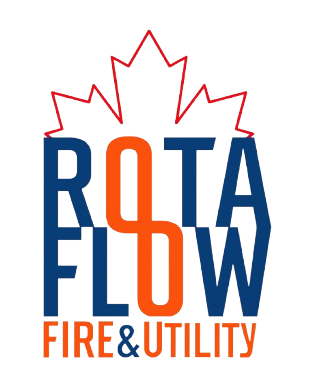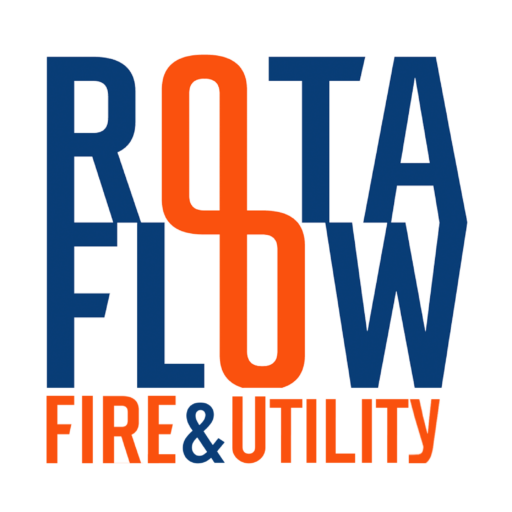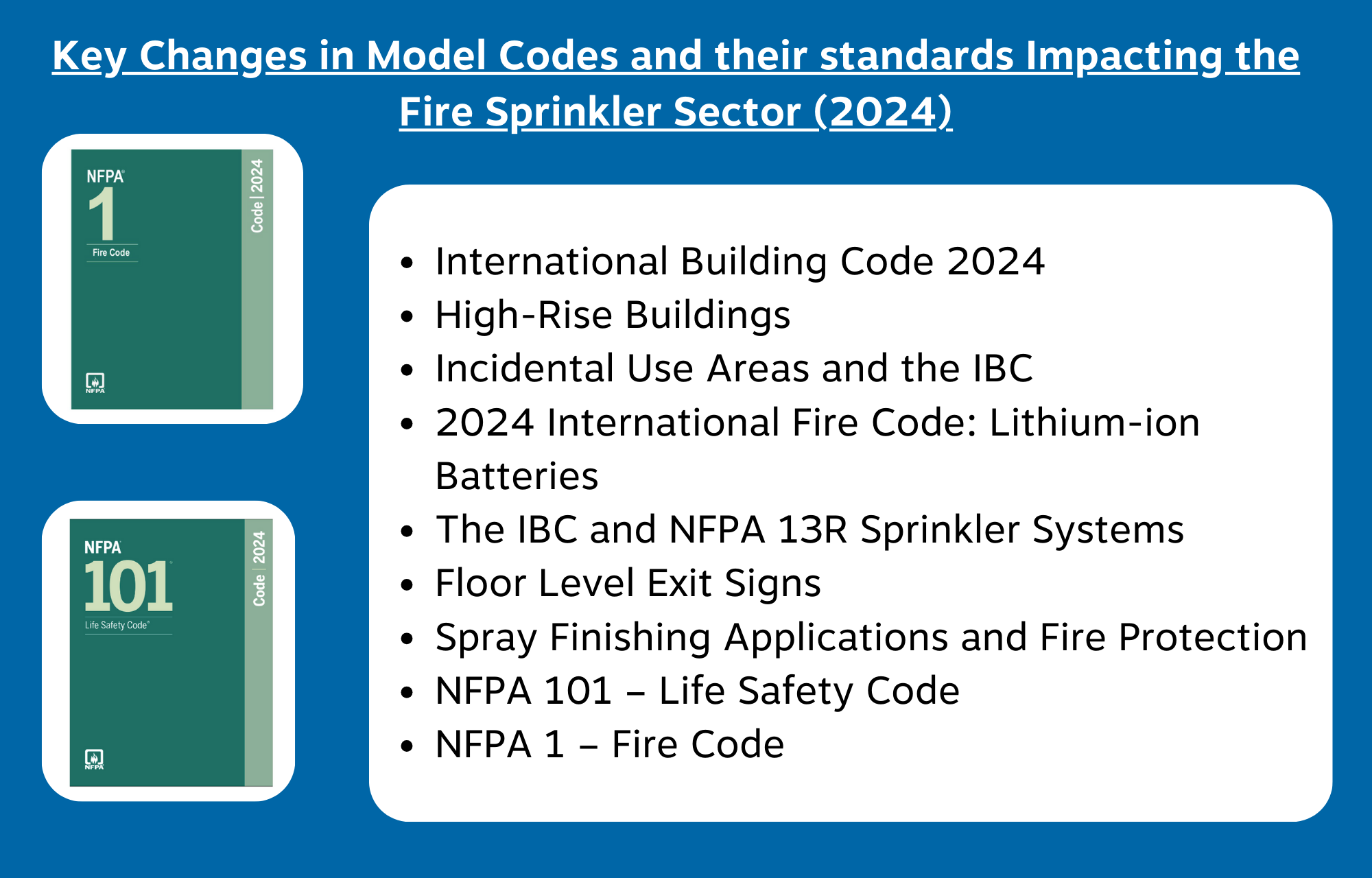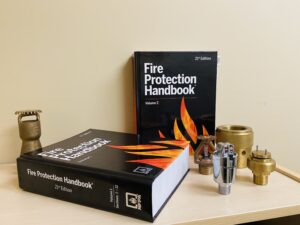The International Code Council (ICC) and the National Fire Protection Association (NFPA) update their codes and standards every three years to reflect the most recent methods, practices, and techniques in the built environment, with the overarching purpose of improving safety. On the one hand, it is critical that the codes and standards used across the built environment be updated to reflect modern construction techniques and practices. On the other hand, we are all aware of how quickly technology may evolve. In three years, a lot can (and often does) change.
This article will examine some of the key changes to model codes and standards that have occurred between the 2021 and 2024 versions of the International Building Code (IBC), International Fire Code (IFC), NFPA 1, and NFPA 101, all of which have a direct impact on the fire sprinkler sector.
International Building Code 2024
Why do changes in model codes affect fire sprinkler designers and sprinkler contractors in general? The terms “Condition 1” and “Condition 2” are used in the 2021 IBC and IFC to apply the fire protection criteria based on the occupants’ mobility, or lack thereof, and if the occupants require aid with evacuation. These terms are utilized in the definitions of Group I-1 and Group R-4 occupancy. Condition 2 pertains to persons who require “limited verbal or physical assistance while responding to an emergency.” However, because the code never specified “limited verbal or physical assistance,” the decision was left to the design expert and code official. The 2024 IBC clarified and introduced a definition to help determine if individuals require verbal or physical aid during evacuation. This is significant for sprinkler designers since the Condition 1 or 2 categorization can make the difference between an NFPA 13R sprinkler system being required and an NFPA 13D sprinkler system being permitted.
High-Rise Buildings
Another significant adjustment made in the 2024 IBC was to high-rise buildings. Design experts and code officials may already be aware that high-rise buildings (buildings having an occupied floor more than 75 feet above fire department truck access) have their own section in IBC Chapter 4. According to the 2024 IBC, the “high-rise” term now applies where an occupiable roof is located over the 75-foot mark. This change means that an existing building that was not considered a high-rise under previous codes can now be classified as a high-rise (IBC Section 403) using the “change of occupancy” provision if the owner repurposes the roof to make it an occupied space and the roof is more than 75 feet above the lowest level of fire department vehicle access.
Incidental Use Areas and the IBC
Another change to the IBC that affects fire prevention is the incidental use area provisions in Section 509. A room, space, or location regarded as having an accessory function associated with an occupancy that offers a higher level of danger to that occupancy is referred to as an incidental use area. In other words, incidental use zones are rooms or spaces in an occupation that pose a higher risk. A furnace room with a furnace that produces more than 400,000 BTUs per hour or a chemistry lab within a high school are two examples. Historically, the code required incidental use spaces to be fire isolated or sprinkler protected.
The code will mandate both fire separation and sprinkler protection in select, limited circumstances. According to the 2024 IBC, incidental use zones in ambulatory care facilities must be segregated from the rest of the building by a 1-hour fire barrier and protected with fire sprinklers. It is critical to note that ambulatory care facilities include structures used for medical, surgical, psychiatric, nursing, or similar purposes on a less-than-24-hour basis where the individuals are incapable of self-preservation. In other words, the occupant(s) require help evacuating. These do not include traditional doctor’s or dentist’s offices. It will, however, most certainly include day surgery centers where patients are treated under general anesthesia.
2024 International Fire Code: Lithium-ion Batteries
Several amendments were made to the 2024 IBC and IFC regarding the usage and storage of lithium-ion batteries, particularly lithium-ion battery-powered equipment. Sprinkler protection was required in previous editions of the IFC when lithium-ion batteries were utilized in conjunction with an energy storage system. Fire sprinklers are now needed for Group B, F-1, M, and S-1 buildings that use or store these batteries, whether or not they are used in connection with an energy storage system. Examples include battery testing, research and development, battery manufacturing, storage, and/or selling, to name a few.
The IBC and NFPA 13R Sprinkler Systems
Another notable modification to the 2024 IBC and IFC relates to NFPA 13R sprinkler systems, specifically when they are permitted based on building height. The codes have included limits for when NFPA 13R can be utilized since the 2015 IBC, especially for podium-style buildings. When all of the following conditions were met, the 2021 IFC permitted NFPA 13R sprinkler systems:
- Above-grade plane of four floors or fewer.
- The topmost story’s floor level is 30 feet or less above the lowest level of fire department truck access.
- The lowest story’s floor level is 30 feet or less below the lowest level of fire department truck access.
However, there was an unintentional error committed when this part was updated between the IBC and IFC versions of 2018 and 2021. The difficulty with this change is that condition #2 limits the height of most residential buildings protected by an NFPA 13R system to three stories. The intention has always been to allow NFPA 13R up to and including four-story buildings. Another significant modification in the 2021 editions was the clarification of the number of stories of Group R occupancy that must be measured from the grade plane. Previously, the number of stories could be calculated from the horizontal assembly that created the occupancy separation.
It was approved that the NFSA codes and standards team’s code amendment for the 2024 IBC would change Section 903.3.1.2 again to raise the 30 foot requirement for Group R-2 occupancies to 45 feet. It is critical to note that this modification only applies to Group R-2 occupancy (not Group R-1). The 30-foot minimum added to the 2021 IBC prohibits residential buildings on top of podiums but also affects standalone R-2 multi-family occupancies, according to criticism collected by NFSA from contractors, developers, and design professionals. The revision in 2024 will allow NFPA 13R for four-story buildings. The 30-foot restriction, based on average floor ceiling assemblies and ceiling heights seen in apartment buildings, mistakenly confined NFPA 13R systems to three stories, which was not the intention.

Floor Level Exit Signs
Another modification that will largely affect authorities having jurisdiction (AHJ) applies to floor-level EXIT signs in Group R-1 (hotel/motel) occupancies. When the building is protected throughout with an NFPA 13 or NFPA 13R sprinkler system, the 2024 IBC allows for the deletion of floor-level EXIT signage.

Spray Finishing Applications and Fire Protection
For many years, the IFC has included fire protection regulations for spraying combustible finishes (spray booths, rooms, etc.). Sprinkler installation criteria are specified in NFPA 13 and NFPA 33 for ducts that exhaust hazardous vapors from these places. However, as stated in the first section of this article, regulations and standards must be revised to reflect and effectively handle new dangers introduced into the built environment. Inflatable and movable cages for spraying flammable finishes have become available on the market in recent years. The issue with these spray enclosures is that they frequently fail to meet the criteria outlined in Chapter 24 of the IFC. Spray enclosures used for the application of flammable finishes must be noncombustible or limited combustible and provided with fire protection in the spraying space and the exhaust duct, according to the IFC and NFPA 33. Inflatable spray enclosures frequently fail to meet this criteria.
NFPA 1 – Fire Code
The 2024 edition of NFPA 1 also includes many revisions affecting the sprinkler industry and authorities with jurisdiction.
A new provision in NFPA 1 permits the authority with jurisdiction to modify or postpone code-related inspections of fire prevention systems and equipment in response to declared disasters on a national, regional, or local level.
The usage of cooking equipment on multi-family dwelling decks and balconies has been amended and reformatted. Sprinkler protection is available on balconies and any overhanging structures, and a new section now permits the use of NFPA 13 or NFPA 13R sprinkler systems to protect cooking equipment on decks and balconies. Cooking appliances are also authorized on decks and balconies of Type I or II residential occupancies where they are listed and labeled in compliance with UL 1026. The 2024 edition further stated that a minimum distance of 24 inches from the building and combustible materials must be established and maintained.
A new version of Section 13.1.9 says that if any impairments, critical deficiencies, or non-critical deficiencies are found during maintenance on a fire protection system, they must be fixed or fixed within a timeframe that the AHJ agrees with, and a plan for managing impairments or deficiencies must be put in place until they are fixed.
To explain that private fire service mains must be examined, tested, and maintained in compliance with NFPA 25, new language was added. Previous editions of NFPA 1 only mandated “maintenance” of fire service mains.

NFPA 101 – Life Safety Code
New requirements for “alternate care sites” were introduced to the NFPA 101 -Life Safety Code. During the pandemic, there was a demand for temporary medical clinics and/or care facilities in places that were not normally used for medical care. An arena adapted for temporary use as a medical facility or hospital is one example.
The term “alternate care site” now refers to any building, structure, or part of it that is not in use for medical purposes but is temporarily repurposed, constructed, converted, or moved for medical purposes in response to an urgent need for more capacity to serve an impacted community.
Finally, NFPA 101 mandates that all new parking structures have an automated sprinkler system to protect them, regardless of their square footage or number of floors. Many vehicles today are composed of plastic and feature products such as lithium-ion batteries, which makes responding firefighters’ jobs more difficult. This is also why, in the 2022 version of NFPA 13, automotive parking garages were shifted from ordinary hazard group 1 to ordinary hazard group 2.
This article has some of the key modifications to the rules that have a direct influence on fire sprinkler designers, contractors, and authorities with jurisdiction. Some of these modifications will have no direct influence on fire sprinkler designers or contractors, but nearly all of them will have an impact on authorities with authority who are in charge of applying, interpreting, and enforcing the regulations in their individual areas. You are not alone in feeling overwhelmed by all of the changes that occur between the many rules and standards. Don’t worry, the NFSA’s code development team is committed to keeping you informed of these changes so you can do your work more successfully.

Courtesy: J.Swanson, Codes and Standards Specialist for the NFSA.



